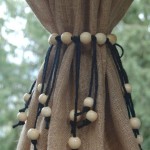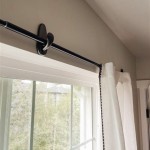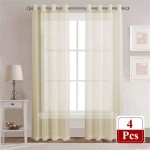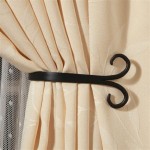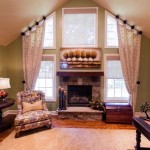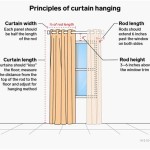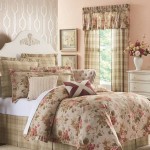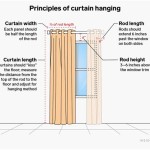Vintage Tie Backs For Curtains: A Timeless Accent
Vintage tie backs for curtains offer a unique and elegant way to control light and enhance the aesthetic appeal of a room. More than mere functional accessories, these decorative hardware pieces often represent a specific era or design movement, adding a touch of history and character to modern and traditional interiors alike. From intricate Victorian designs to streamlined Art Deco forms, vintage tie backs present a diverse range of styles that can complement a wide variety of curtain fabrics and interior design schemes.
The term "vintage" generally refers to items that are at least 20 to 30 years old but not yet considered antiques, which are typically over 100 years old. Vintage tie backs can be crafted from various materials, including metal (brass, iron, bronze), wood, glass, ceramic, and even textiles. The choice of material often reflects the prevalent design styles of the period in which the tie backs were made. Understanding the key characteristics of different vintage tie back styles can assist in selecting pieces that harmonize with the existing decor and achieve the desired visual effect.
Identifying Key Styles and Materials
The vast array of vintage tie back styles necessitates a systematic approach to identification. Recognizing the popular design motifs and materials used during different periods facilitates informed purchasing and allows for a cohesive integration of these elements into a room's overall design.
Victorian tie backs, for example, are often characterized by their ornate detailing and elaborate designs. These frequently incorporate floral motifs, scrolls, and other decorative elements, reflecting the opulent aesthetic of the Victorian era. Common materials include brass, bronze, and cast iron, often with finishes that emphasize the intricate detailing. These tie backs can add a touch of grandeur and formality to a space, particularly when paired with heavy, luxurious curtain fabrics such as velvet or brocade.
Art Deco tie backs, in contrast, tend to feature streamlined geometric shapes and symmetrical designs. The Art Deco movement, which flourished in the 1920s and 1930s, emphasized clean lines, bold colors, and modern materials. Tie backs from this period may be made of chrome, Bakelite, or glass, often incorporating geometric patterns such as chevrons, zigzags, and stylized floral motifs. They offer a sophisticated and chic alternative to more traditional styles and work well with lighter, more contemporary curtain fabrics.
Mid-Century Modern tie backs, popular from the 1940s to the 1960s, often prioritize functionality and simplicity. These designs typically feature clean, minimalist lines and are made from materials such as wood, ceramic, or metal. The emphasis is on understated elegance and practicality, making them suitable for modern and contemporary interiors. Common shapes include simple circles, squares, and stylized organic forms. They pair well with linen, cotton, and other natural fabrics, contributing to a relaxed and understated aesthetic.
Furthermore, textile tie backs, prevalent throughout various historical periods, provide a softer and more flexible alternative to rigid materials. These can be crafted from silk, velvet, corduroy, or other fabrics, often embellished with embroidery, beads, or tassels. Textile tie backs offer a wider range of color and texture options, allowing for greater customization and coordination with the curtain fabric and overall room decor. The choice of textile can significantly influence the mood and style of the room, ranging from rustic and bohemian to elegant and refined.
Factors to Consider When Choosing Vintage Tie Backs
Selecting the right vintage tie backs requires careful consideration of several factors, including the style and weight of the curtains, the overall decor of the room, and the desired level of functionality. A mismatch between the tie backs and the curtains or the room's design can detract from the overall aesthetic and create a visual imbalance.
The weight and style of the curtains are crucial considerations. Heavy curtains, such as those made of velvet or brocade, require sturdy tie backs that can effectively hold them back without sagging or slipping. Metal tie backs, particularly those made of brass or cast iron, are generally best suited for heavier curtains. Lighter curtains, such as those made of linen or cotton, can be paired with more delicate tie backs made of wood, glass, or textile. The style of the curtains should also complement the style of the tie backs. For example, ornate Victorian tie backs would be more appropriate for formal drapes than for simple, unadorned curtains.
The overall decor of the room should also be taken into account. The tie backs should harmonize with the existing furniture, accessories, and color scheme. A room decorated in a traditional style would benefit from tie backs that reflect this aesthetic, such as those with ornate detailing and classic materials. A more modern room, on the other hand, might be better suited to tie backs with clean lines and minimalist designs. The goal is to create a cohesive and balanced look that enhances the overall appeal of the space.
The desired level of functionality is another important factor to consider. If the primary purpose of the tie backs is simply to hold the curtains back, a simple and functional design may suffice. However, if the tie backs are intended to be a decorative element in their own right, more elaborate and visually striking designs may be preferred. The choice will depend on individual preferences and the overall design goals.
Furthermore, the placement of the tie backs can significantly affect the overall look and functionality. Tie backs are typically installed at a height that allows the curtains to drape gracefully when held back. The exact height will depend on the length of the curtains and the desired level of fullness. Experimenting with different placements can help to achieve the optimal aesthetic and functional balance.
Caring for and Maintaining Vintage Tie Backs
Proper care and maintenance are essential for preserving the beauty and longevity of vintage tie backs. The specific cleaning and maintenance techniques will vary depending on the material from which the tie backs are made. Neglecting these aspects can lead to deterioration, tarnishing, or other forms of damage that can detract from their value and appearance.
Metal tie backs, particularly those made of brass or bronze, are prone to tarnishing over time. Regular cleaning with a soft cloth and a specialized metal cleaner can help to remove tarnish and restore their original shine. Avoid using abrasive cleaners or scouring pads, as these can scratch the surface and damage the finish. For heavily tarnished metal tie backs, professional cleaning may be necessary.
Wooden tie backs should be cleaned with a soft, damp cloth and a mild soap solution. Avoid using excessive amounts of water, as this can damage the wood. After cleaning, dry the tie backs thoroughly with a clean cloth. Furniture polish can be used to protect the wood and enhance its appearance. Check for signs of damage, such as cracks or splinters, and repair them as needed.
Glass and ceramic tie backs can be cleaned with a soft, damp cloth and a mild glass cleaner. Avoid using abrasive cleaners or scouring pads, as these can scratch the surface. Inspect the tie backs for chips or cracks and handle them with care to prevent further damage. Delicate glass tie backs may require professional cleaning.
Textile tie backs should be cleaned according to the fabric's specific care instructions. Some textile tie backs may be machine washable, while others may require dry cleaning. Avoid using harsh detergents or bleach, as these can damage the fabric. Inspect the tie backs for stains or tears and repair them as needed. Proper storage can help to prevent damage from dust, sunlight, and moisture.
In addition to regular cleaning, it is also important to protect vintage tie backs from physical damage. Avoid placing heavy objects on them or exposing them to extreme temperatures or humidity. Store them in a safe place when they are not in use. By following these simple care and maintenance tips, it is possible to preserve the beauty and value of vintage tie backs for years to come.

Antique Doorknob Design Curtain Tie Backs Silver Color Pair Of 2

Vintage Row Solid Brass Curtain Tiebacks Gold Modern Hold Backs Wall Hooks Window Accessories Home Decor Gifts Etsy

Antique Tassels Curtain Tiebacks French Passementerie Gold Metallic Trimming

2curtain Tie Backs Pcs Exquisite Vintage Curtain Tiebacks Hooks

Vintage Creative Brass Curtain Tiebacks Gold Modern Hold Backs Wall Hooks Window Accessories Home Decor Gifts Etsy

Pair Of Flying Swallow Bird Solid Brass Curtain Holdbacks Vintage Style Tieback

Fall Decor French Country Curtain Tie Backs Handmade Velvet Roses Holder Shabby Chic Vintage Cottage Tiebacks For Curtains Etsy

Antique Curtain Tie Backs Brass Gilt Rococo Vintage French

2 Pcs Decorative Hooks Vintage Tieback Curtain Wall Curtains Backs Holdback

8 Diffe Ways To Tie Back Curtains

